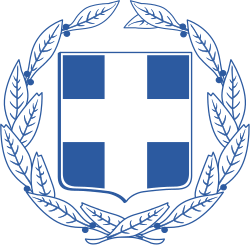Greek Town riot
| Part of a series on |
| Ethnicity in Omaha |
|---|
|
|
The Greek Town riot was a race riot in South Omaha, Nebraska on February 21, 1909.[1] 3,000 men were responsible for killing one boy, displacing the entire population of Greek Town, and burning down the Greek neighborhood in South Omaha.[2]
Background
In February 1909, a Greek immigrant man was taking English lessons from a young woman in South Omaha. For some reason, a policeman named Edward Lowry (of Irish descent) arrested him and the young woman on February 19, 1909. While Lowry transported them to the jailhouse, the Greek man pulled out a handgun and mortally wounded the officer.[3] Greek immigrants had come to the city as strikebreakers, and earlier arrivals resented them. Among those who were hostile were ethnic Irish, who had a large community in South Omaha. Omaha newspapers were particularly renowned for their yellow journalism during this period. They fanned racist flames with salacious headlines about the case.[4] The Omaha Daily News wrote, "Their quarters have been unsanitary; they have insulted women... Herded together in lodging houses and living cheaply, Greeks are a menace to the American laboring man – just as the Japs, Italians, and other similar laborers are."[5]
When the Greek perpetrator was finally apprehended, two state legislators (one of Irish descent) and an attorney called a mass meeting of more than 900 men. They "harangued the mob", raising emotions against the Greeks.[6] The mob, gathering more men along the way, thronged around the South Omaha Jail where the Greek prisoner was being held. The police decided it was unsafe to keep him there and decided to move their prisoner to the main Omaha jail. The mob followed the police wagon as it left the jail. More than once they got their hands on the prisoner. At one point they almost lynched him.
Riot
After the wagon escaped their grasp, the agitated men turned back towards South Omaha. On February 21 a mob of more than 1,000 men stormed "Greek Town."[7] The New York Times carried an article about the riot stating that 3,000 men were in the mob.[8] They looted homes and businesses, beat Greek men, women and children, and burnt down every building in the area. One Greek boy was reportedly killed.[9] The entire population of Greeks in South Omaha were warned to leave the city within one day, or risk the ongoing wrath of the mob. During the violence, the South Omaha police could not control the mob. They asked for help from Omaha, then a separate city, but Omaha decided against sending its own police forces to South Omaha. Within a few days, all the Greeks living in South Omaha fled the city, moving to Council Bluffs, Sioux City and Salt Lake City.[10]
Aftermath
Soon after, the Greek who mortally wounded Lowry was brought to trial. The suspect was convicted and sentenced to death. The Nebraska Supreme Court reversed the verdict on appeal, because the mob passions in the city had denied him a fair trial. During a second trial, the man was found guilty of second-degree murder and sentenced to 14 years in prison. After serving five and a half years, the man was furloughed by the governor and deported from the United States.[11] At the trial, the Greek vice-consul to the United States asked the Federal government to provide an explanation of the expulsion of Greeks from Omaha, as well the failure in government protection of Greek residents. The court trial dragged on and no excuse was ever provided.[12]
See also
References
- ↑ "The only obstacle to immigration applies to but one race and is not general in its nature. Strong racial prejudice has existed for a great many years against the Greeks. It reached its climax in a race riot a few years ago, when the entire Greek settlement was driven from the community by a mob. Immigrants of other races meet with no general obstacles."Dillingham, W.P. (1918) Reports of the Dillingham Commission: Immigrants in the Industries, p 344.
- ↑ "South Omaha mob wars on Greeks", The New York Times. February 21, 1909. Retrieved 4/16/08.
- ↑ Officer Lowry also pulled out his service revolver and shot the Greek man."Edward Lowry", Officer Down Memorial Page. Retrieved 5/11/08.
- ↑ Larsen, L. & Cotrell, B. (1997). The gate city: A history of Omaha. University of Nebraska Press. P 165.
- ↑ (nd) "Racial tension in Nebraska in the 1920s." NebraskaStudies.Org. Retrieved 6/7/07.
- ↑ "South Omaha mob wars on Greeks", The New York Times. February 21, 1909. Retrieved 4/16/08.
- ↑ Larsen, L. & Cotrell, B. (1997). The gate city: A history of Omaha. University of Nebraska Press. P 164.
- ↑ "South Omaha mob wars on Greeks", The New York Times. February 21, 1909. Retrieved 4/16/08.
- ↑ Hill, J. (nd) “Interview: Helen Papanikolas.”
- ↑ Larsen, L. & Cotrell, B. (1997). The gate city: A history of Omaha, Lincoln: University of Nebraska Press, p. 166.
- ↑ "Edward Lowry", Officer Down Memorial Page, retrieved 5/11/08
- ↑ Larsen, L. & Cotrell, B. (1997). The gate city: A history of Omaha. University of Nebraska Press. P 166.
